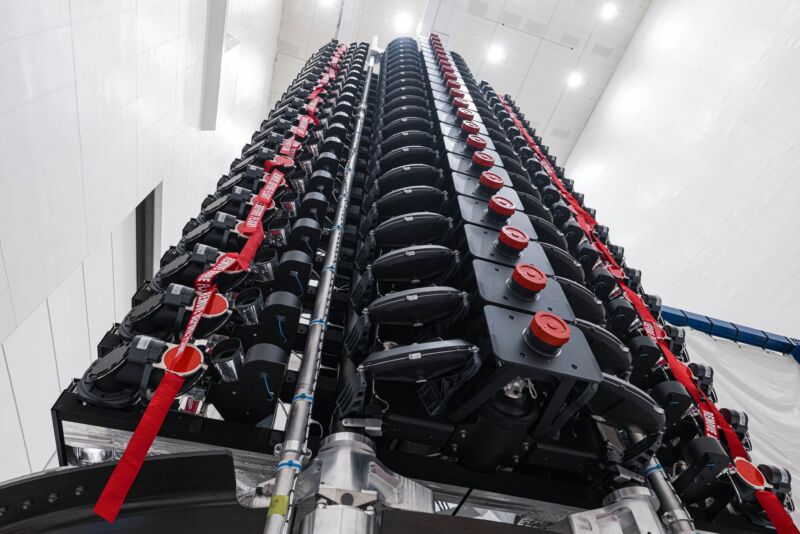
reader comments
102 with
With Starlink speeds slowing due to a growing capacity crunch, SpaceX said a launch happening as soon as today will deploy the first “V2 Mini” satellites that provide four times more per-satellite capacity than earlier versions.
Starlink’s second-generation satellites include the V2 Minis and the larger V2. The larger V2s are designed for the SpaceX Starship, which isn’t quite ready to launch yet, but the V2 Minis are slimmed-down versions that can be deployed from the Falcon 9 rocket.
“The V2 Minis are smaller than the V2 satellites (hence the name) but don’t let the name fool you,” SpaceX said in a statement provided to Ars yesterday. “The V2 Minis include more advanced phased array antennas and the use of E-band for backhaul, which will enable Starlink to provide ~4x more capacity per satellite than earlier iterations.”
SpaceX didn’t specify the amount of data that each V2 Mini satellite can provide, but its first-generation satellites were designed for an aggregate downlink capacity of 17 to 23Gbps per satellite. We asked SpaceX for details on the V2 Mini’s per-satellite capacity and whether current user terminals installed at customers’ homes can take full advantage of the speed boosts, and will update this article if we get a response.
The Federal Communications Commission recently gave SpaceX approval to launch 7,500 of the 30,000 planned second-generation satellites. A SpaceX Falcon 9 launch tentatively scheduled for today would put 21 V2 Minis into orbit.
partnership announced in August 2022.
Starlink speeds drop amid price hike and data cap
Many launches will likely be required for the second-generation satellites to have a noticeable impact on broadband performance. Starlink has nearly 3,700 first-generation satellites in orbit, but speeds have slowed as more users sign up. In large portions of the US, people who want Starlink have to sign up for a waiting list.
SpaceX has already imposed pricing changes that may be intended to manage capacity limits. Starlink last week notified residential users in “limited-capacity” areas that their monthly service price will increase from $110 to $120, while users in “excess-capacity” areas will get a price cut and pay only $90 going forward. Starlink also has a new data cap in which customers who go over 1TB in any given month will get slower speeds unless they pay extra for additional high-speed data.
Despite the name, the V2 Minis are bigger and heavier than first-generation Starlink satellites that weighed about 295 kilograms each. “Each Starlink V2 Mini satellite weighs about 1,760 pounds (800 kilograms) at launch, nearly three times heavier than the older Starlink satellites,” Spaceflight Now reported. “They are also bigger in size, with a spacecraft body more than 13 feet (4.1 meters) wide, filling more of the Falcon 9 rocket’s payload fairing during launch.”
Compared to the 21 second-gen satellites set for launch as soon as today, Starlink was able to deploy about 60 satellites per launch with the smaller first-generation ones.






